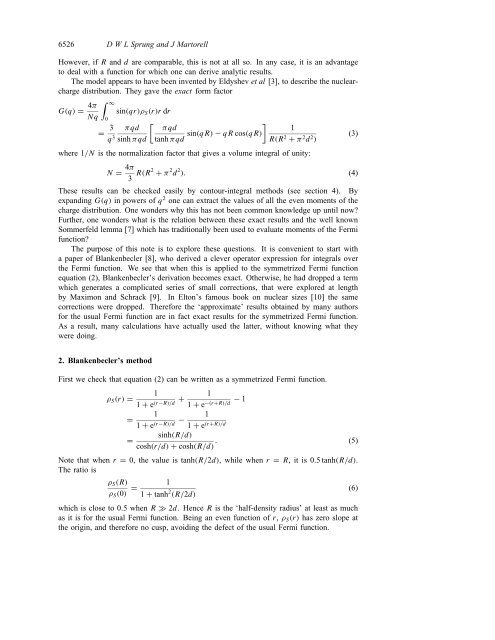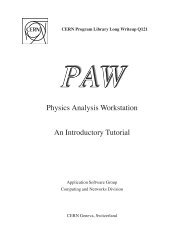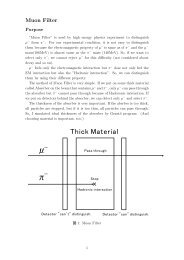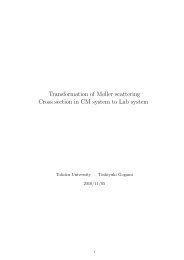The symmetrized Fermi function and its transforms
The symmetrized Fermi function and its transforms
The symmetrized Fermi function and its transforms
Create successful ePaper yourself
Turn your PDF publications into a flip-book with our unique Google optimized e-Paper software.
6526 D W L Sprung <strong>and</strong> J Martorell<br />
However, if R <strong>and</strong> d are comparable, this is not at all so. In any case, it is an advantage<br />
to deal with a <strong>function</strong> for which one can derive analytic results.<br />
<strong>The</strong> model appears to have been invented by Eldyshev et al [3], to describe the nuclearcharge<br />
distribution. <strong>The</strong>y gave the exact form factor<br />
G(q) = 4π<br />
Nq<br />
∫ ∞<br />
0<br />
sin(qr)ρ S (r)r dr<br />
= 3 q 3 πqd<br />
sinh πqd<br />
[ πqd<br />
tanh πqd sin(qR) − qR cos(qR) ]<br />
1<br />
R(R 2 + π 2 d 2 )<br />
where 1/N is the normalization factor that gives a volume integral of unity:<br />
N = 4π 3 R(R2 + π 2 d 2 ). (4)<br />
<strong>The</strong>se results can be checked easily by contour-integral methods (see section 4). By<br />
exp<strong>and</strong>ing G(q) in powers of q 2 one can extract the values of all the even moments of the<br />
charge distribution. One wonders why this has not been common knowledge up until now<br />
Further, one wonders what is the relation between these exact results <strong>and</strong> the well known<br />
Sommerfeld lemma [7] which has traditionally been used to evaluate moments of the <strong>Fermi</strong><br />
<strong>function</strong><br />
<strong>The</strong> purpose of this note is to explore these questions. It is convenient to start with<br />
a paper of Blankenbecler [8], who derived a clever operator expression for integrals over<br />
the <strong>Fermi</strong> <strong>function</strong>. We see that when this is applied to the <strong>symmetrized</strong> <strong>Fermi</strong> <strong>function</strong><br />
equation (2), Blankenbecler’s derivation becomes exact. Otherwise, he had dropped a term<br />
which generates a complicated series of small corrections, that were explored at length<br />
by Maximon <strong>and</strong> Schrack [9]. In Elton’s famous book on nuclear sizes [10] the same<br />
corrections were dropped. <strong>The</strong>refore the ‘approximate’ results obtained by many authors<br />
for the usual <strong>Fermi</strong> <strong>function</strong> are in fact exact results for the <strong>symmetrized</strong> <strong>Fermi</strong> <strong>function</strong>.<br />
As a result, many calculations have actually used the latter, without knowing what they<br />
were doing.<br />
(3)<br />
2. Blankenbecler’s method<br />
First we check that equation (2) can be written as a <strong>symmetrized</strong> <strong>Fermi</strong> <strong>function</strong>.<br />
ρ S (r) =<br />
=<br />
=<br />
1<br />
1 + e + 1<br />
(r−R)/d<br />
1<br />
1 + e − 1<br />
(r−R)/d<br />
1 + e −(r+R)/d − 1<br />
1 + e (r+R)/d<br />
sinh(R/d)<br />
cosh(r/d) + cosh(R/d) . (5)<br />
Note that when r = 0, the value is tanh(R/2d), while when r = R, itis0.5 tanh(R/d).<br />
<strong>The</strong> ratio is<br />
ρ S (R)<br />
ρ S (0) = 1<br />
1 + tanh 2 (6)<br />
(R/2d)<br />
which is close to 0.5 when R ≫ 2d. Hence R is the ‘half-density radius’ at least as much<br />
as it is for the usual <strong>Fermi</strong> <strong>function</strong>. Being an even <strong>function</strong> of r, ρ S (r) has zero slope at<br />
the origin, <strong>and</strong> therefore no cusp, avoiding the defect of the usual <strong>Fermi</strong> <strong>function</strong>.









